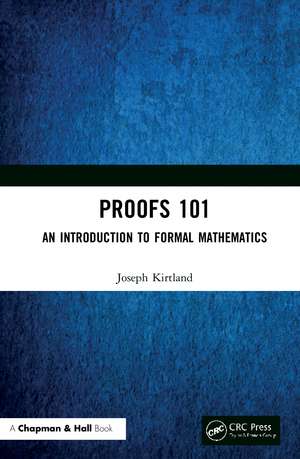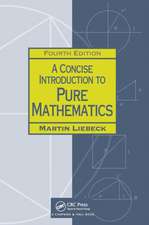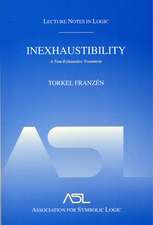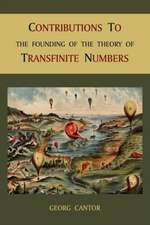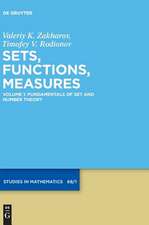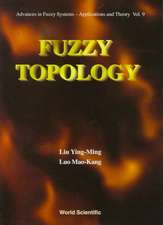Proofs 101: An Introduction to Formal Mathematics
Autor Joseph Kirtlanden Limba Engleză Hardback – 20 noi 2020
The book prepares students for the proofs they will need to analyze and write the axiomatic nature of mathematics and the rigors of upper-level mathematics courses. Basic number theory, relations, functions, cardinality, and set theory will provide the material for the proofs and lay the foundation for a deeper understanding of mathematics, which students will need to carry with them throughout their future studies.
Features
- Designed to be teachable across a single semester
- Suitable as an undergraduate textbook for Introduction to Proofs or Transition to Advanced Mathematics courses
- Offers a balanced variety of easy, moderate, and difficult exercises
| Toate formatele și edițiile | Preț | Express |
|---|---|---|
| Paperback (1) | 463.62 lei 6-8 săpt. | |
| CRC Press – 20 noi 2020 | 463.62 lei 6-8 săpt. | |
| Hardback (1) | 1000.30 lei 6-8 săpt. | |
| CRC Press – 20 noi 2020 | 1000.30 lei 6-8 săpt. |
Preț: 1000.30 lei
Preț vechi: 1219.88 lei
-18% Nou
Puncte Express: 1500
Preț estimativ în valută:
191.40€ • 200.38$ • 158.38£
191.40€ • 200.38$ • 158.38£
Carte tipărită la comandă
Livrare economică 05-19 aprilie
Preluare comenzi: 021 569.72.76
Specificații
ISBN-13: 9780367536930
ISBN-10: 0367536935
Pagini: 196
Ilustrații: 18 Illustrations, black and white
Dimensiuni: 156 x 234 x 13 mm
Greutate: 0.45 kg
Ediția:1
Editura: CRC Press
Colecția Chapman and Hall/CRC
ISBN-10: 0367536935
Pagini: 196
Ilustrații: 18 Illustrations, black and white
Dimensiuni: 156 x 234 x 13 mm
Greutate: 0.45 kg
Ediția:1
Editura: CRC Press
Colecția Chapman and Hall/CRC
Cuprins
1. Logic. 1.1 Introduction. 1.2. Statements and Logical Connectives. 1.3 Logical Equivalence. 1.4. Predicates and Quantifiers. 1.5. Negation. 2. Proof Techniques. 2.1. Introduction. 2.2. The Axiomatic and Rigorous Nature of Mathematics. 2.3. Foundations. 2.4. Direct Proof. 2.5. Proof by Contrapositive. 2.5. Proof by Cases. 2.6. Proof by Contradiction. 3. Sets. 3.1. The Concept of a Set. 3.2. Subset of Set Equality. 3.3. Operations on Sets. 3.4. Indexed Sets. 3.5. Russel’s Paradox. 4. Proof by Mathematical Induction. 4.1. Introduction. 4.2. The Principle of Mathematical Induction. 4.3. Proof by strong Induction. 5. Relations. 5.1. Introduction. 5.2. Properties of Relations. 5.3. Equivalence Relations. 6. Introduction. 6.1. Definition of a Function. 6.2. One-To-One and Onto Functions. 6.3. Composition of Functions. 6.4. Inverse of a Function. 7. Cardinality of Sets. 7.1. Introduction. 7.2. Sets with the same Cardinality. 7.3. Finite and Infinite Sets. 7.4. Countably Infinite Sets. 7.5. Uncountable Sets. 7.6 Comparing Cardinalities.
Notă biografică
Author
Joseph Kirtland received his BS from Syracuse University and PhD in mathematics from the University of New Hampshire. He joined the faculty of Marist College in 1992. A highly respected teacher, he has been selected ten times by the students for the Faculty Recognition Award in the School of Computer Science and Mathematics. In 2000, he was presented with the Marist College Board of Trustee's Distinguished Teaching Award, and in 2002, he received the Award for Distinguished College or University Teaching of Mathematics given by the Metropolitan New York section of the Mathematical Association of America. In addition, his first book Identification Numbers and Check Digit Schemes won the Mathematical Association of America’s Beckenbach Book Prize in 2002.
Dr. Kirtland’s professional interests include finite and infinite group theory, applications of group theory, and mathematics education. He also enjoys poetry (Philip Larkin and Mary Oliver are two of his favorite poets), hiking (he and his wife have hiked nearly ever trail in the Catskill Mountains), and cycling (his bike can often be found in northern Dutchess County, NY).
Joseph Kirtland received his BS from Syracuse University and PhD in mathematics from the University of New Hampshire. He joined the faculty of Marist College in 1992. A highly respected teacher, he has been selected ten times by the students for the Faculty Recognition Award in the School of Computer Science and Mathematics. In 2000, he was presented with the Marist College Board of Trustee's Distinguished Teaching Award, and in 2002, he received the Award for Distinguished College or University Teaching of Mathematics given by the Metropolitan New York section of the Mathematical Association of America. In addition, his first book Identification Numbers and Check Digit Schemes won the Mathematical Association of America’s Beckenbach Book Prize in 2002.
Dr. Kirtland’s professional interests include finite and infinite group theory, applications of group theory, and mathematics education. He also enjoys poetry (Philip Larkin and Mary Oliver are two of his favorite poets), hiking (he and his wife have hiked nearly ever trail in the Catskill Mountains), and cycling (his bike can often be found in northern Dutchess County, NY).
Recenzii
"An ideal curriculum textbook, Proofs 101: An Introduction to Formal Mathematics is exceptionally well organized and presented. A core and essential addition to college and university library Mathematics collections"
– Midwest Book Review
" I wished I had Proofs 101: An Introduction to Formal Mathematics as a textbook when I was a student!"
– Luise-Charlotte Kappe, Professor Emerita, Binghamton University
"As undergraduate students mature in their study of mathematics, they face learning the writing of proofs. From his extensive classroom experience, Kirtland has fashioned a guide to these new levels of maturity. This book presents a carefully constructed tour whose sights include the foundations and most useful techniques of proof, as well as visits to the houses of number theory and set theory where these methods support results. The presentation is conversational, like a good proof can be, and focuses on what proofs reveal instead of the mechanics of writing them.
Students can develop as mathematicians with this book as a guide."
– John McCleary, Vassar College
"I greatly enjoy the way that the author speaks so directly and freely to the reader (student). The text does a good job of taking hard mathematical concepts and making them into bite-size, easy to digest pieces of information whose purpose and uses are explicitly stated. I also appreciate how the author warns the reader about common misconceptions rather than leading them into a trap through a contrived example. This book not only goes through all of the information and definitions one would need to write a clear and concise statement or proof in mathematics, but also explains the reasoning behind why it's important to do so. It’s an excellent introduction to higher-level mathematical thinking and writing."
– Jennifer Crodelle, Middlebury College
– Midwest Book Review
" I wished I had Proofs 101: An Introduction to Formal Mathematics as a textbook when I was a student!"
– Luise-Charlotte Kappe, Professor Emerita, Binghamton University
"As undergraduate students mature in their study of mathematics, they face learning the writing of proofs. From his extensive classroom experience, Kirtland has fashioned a guide to these new levels of maturity. This book presents a carefully constructed tour whose sights include the foundations and most useful techniques of proof, as well as visits to the houses of number theory and set theory where these methods support results. The presentation is conversational, like a good proof can be, and focuses on what proofs reveal instead of the mechanics of writing them.
Students can develop as mathematicians with this book as a guide."
– John McCleary, Vassar College
"I greatly enjoy the way that the author speaks so directly and freely to the reader (student). The text does a good job of taking hard mathematical concepts and making them into bite-size, easy to digest pieces of information whose purpose and uses are explicitly stated. I also appreciate how the author warns the reader about common misconceptions rather than leading them into a trap through a contrived example. This book not only goes through all of the information and definitions one would need to write a clear and concise statement or proof in mathematics, but also explains the reasoning behind why it's important to do so. It’s an excellent introduction to higher-level mathematical thinking and writing."
– Jennifer Crodelle, Middlebury College
Descriere
This book serves as an introduction to proofs for mathematics majors who have completed the calculus sequence (at least Calculus I and II) and Linear Algebra. It prepares students for the proofs they will need to analyse and write, the axiomatic nature of mathematics, and the rigors of upper-level mathematics courses.
